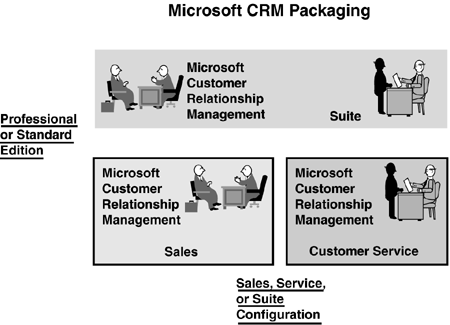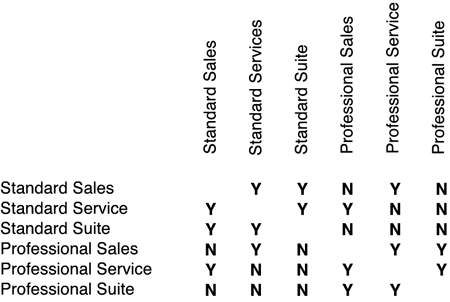Microsoft CRM Versions and Licensing
To begin a discussion of functionality, it is necessary to discuss the product's packaging. Microsoft CRM is sold in three configurations, each of which has two editions. The configurations are Sales, Customer Service, and Suite (the combination of Sales and Customer Service). The editions are standard and professional. As you've probably already guessed, the professional editions have the same functionality as the standard editions, but with some additional features. Figure 4.3 depicts the editions and configurations of Microsoft CRM.
Figure 4.3. A visual overview of the product packaging.

The product packaging is a little tricky at first, but it makes sense when you think about it. To use an example, a company that has basic sales requirements, but complex service requirements can buy Standard Sales licenses for its sales users and Professional Service licenses for its Customer Service users. However, if the same company wants the Sales users to also be able to see the Service-specific information, they will need to give the Sales users Professional Suite licenses. Likewise, if the company wants the Service users to be able to access the Sales-specific information, they will need to give the Service users Professional Suite licenses, and then upgrade the sales users to Professional Sales or Professional Suite. This is because you cannot mix standard and professional users of the same configuration. For example, you cannot give your VP of Sales a Professional Sales license, while all other sales people have a Standard Sales license. It is an all or nothing proposition. When a user has a Professional Suite license, she in effect has a combined Professional Sales and Professional Service license. Therefore, if even one user has a Professional Suite license, no other user can have any of the Standard configurations. So, in the example where even one user has a Professional Suite license, other users can have Professional Sales or Professional Service licenses, but not Standard Sales, Service, or Suite licenses. All this can quickly lead companies to upgrade all their licenses to the Professional versions. Figure 4.4 illustrates the compatibilities between editions and configurations of Microsoft CRM
Figure 4.4. How editions and configurations of Microsoft CRM can be mixed within a single installation.

Microsoft CRM also requires at least one server license to cover the software being run on your organization's CRM server. With respect to the server licenses, there is no Standard versus Professional designation, only a Sales Server and a Service Server. If you have even one Sales user you must purchase the Sales Server. Likewise, if you have even one Service user you must purchase the Service Server. If you have at least one Suite user, you must buy both the Sales and Professional servers.
In the previous paragraph I mentioned Sales- and Service-specific information a couple of times. This merits a short discussion and gets back to the underlying fact that Microsoft CRM has been built as one application. Changing a user's license from Sales Standard to Sales Professional or Suite Professional does not involve running a new setup application or adding new code, objects, or modules. Rather, as with many well-designed applications, changing the license simply enables the use of additional functionality. This is why I have used the term configuration in lieu of module. When Microsoft CRM is installed, all application code is installed and the license key provided by Microsoft Business Solutions enables the functionality that has been purchased. The license key is an alphanumeric character string that Microsoft Business Solutions provides and an administrator enters into the Deployment Manager application. This string tells the application what functionality can be unlocked and in what quantity. The system administrator can then assign “who gets what” functionality when setting up users and roles.
NOTEApplication refers to the Microsoft CRM Server that is installed once per deployment. This includes the user interface (Web pages), business logic (application server), and data storage (database) components. All users of a single deployment access the same Microsoft CRM application and, thus, the same shared database. Users of the Microsoft CRM Sales for Outlook client will also access the same shared database, but will have a separate, local database (on their laptops, for example) for going offline with those records that are assigned to them. |
Regardless of which Microsoft CRM configuration you are using, some core pieces of functionality are common. These core pieces of functionality that all users will have access to are
Account and Contact Management
Activity and Task Management
Security Management
User Management
Calendar
Basic Reporting
Customization Tools
Tables 4.1 through 4.4 outline in more detail the specific features of each configuration of Microsoft CRM.
| Account and Contact Management | Activity & Task Management | Correspondence/Mail Merge |
| Calendar | Search | Territory Management |
| Notes & Attachments | Reports | Microsoft CRM Sales for Outlook |
| Direct Email via Microsoft CRM Exchange Connector | Opportunity Management | Lead Management |
| Quotas | Product Catalog | Sales Process Methodology |
| Quotes, Orders, and Invoices | Competitor Tracking | Lead Routing |
| Workflow | Sales Literature |
| Account and Contact Management | Activity & Task Management | Knowledgebase Management |
| Calendar | Search | Service Request |
| Notes & Attachments | Reports | Activity & Case Queuing |
| Direct Email via Microsoft CRM Exchange Connector | Case Management |
